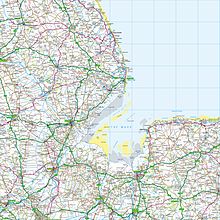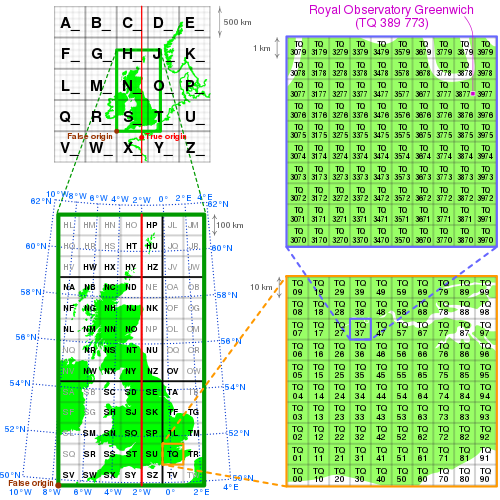User:Peter Mercator/Draft for OS national grid
various mods for Ordnance Survey National Grid
General

The grid is based on the OSGB36 datum (Ordnance Survey Great Britain 1936, based on the Airy 1830 ellipsoid), and was introduced after the retriangulation of 1936–1962.
The Airy ellipsoid is a regional best fit for Britain; more modern mapping tends to use the GRS80 ellipsoid used by the GPS (the Airy ellipsoid assumes the Earth to be about 1 km smaller in diameter than the GRS80 ellipsoid, and to be slightly less flattened). The maps adopt a Transverse Mercator projection with an origin (the "true" origin) at 49° N, 2° W (an offshore point in the English Channel which lies between the island of Jersey and the French port of St. Malo).[1] Over the Airy ellipsoid a straight line grid, the National Grid, is placed with a new false origin (to eliminate negative numbers), creating a 700 km by 1300 km grid. This false origin is located south-west of the Isles of Scilly. The distortion created between the OS grid and the projection is
reduced by scaling the grid coordinates so that the scale on the central meridian is equal to 0.9996[2] and unit scale is achieved only on two slightly[3] curved lines approximately 180 km east and west of the central meridian. Grid north and true north are only aligned on the 400 km easting of the grid which is 2° W (OSGB36) and approx. 2° 0′ 5″ W (WGS 84).
OSGB 36 was also used by Admiralty nautical charts until 2000[citation needed] after which WGS 84 has been used.
A geodetic transformation between OSGB 36 and other terrestrial reference systems (like ITRF2000, ETRS89, or WGS 84) can become quite tedious if attempted manually. The most common transformation is called the Helmert datum transformation, which results in a typical 7 m error from true. The definitive transformation from ETRS89 that is published by the OSGB is called the National Grid Transformation OSTN02.[4] This models the detailed distortions in the 1936–1962 retriangulation, and achieves backwards compatibility in grid coordinates to sub-metre accuracy.
Datum shift between OSGB 36 and WGS 84
The difference between the coordinates on different datums varies from place to place. The longitude and latitude positions on OSGB 36 are the same as for WGS 84 at a point in the Atlantic Ocean well to the west of Great Britain. In Cornwall, the WGS 84 longitude lines are about 70 metres east of their OSGB 36 equivalents, this value rising gradually to about 120 m east on the east coast of East Anglia. The WGS 84 latitude lines are about 70 m south of the OSGB 36 lines in South Cornwall, the difference diminishing to zero in the Scottish Borders, and then increasing to about 50 m north on the north coast of Scotland. (If the lines are further east, then the longitude value of any given point is further west. Similarly, if the lines are further south, the values will give the point a more northerly latitude.) The smallest datum shift is on the west coast of Scotland and the greatest in Kent.
But Great Britain has not shrunk by 100+ metres; a point near Land's End now computes to be 27.6 metres closer to a point near Duncansby Head than it did under OSGB36.[5]
Datum shift between OSGB 36 and ED 50
These two datums are not really both in general use in any one place, but for a point in the English Channel halfway between Dover and Calais, the ED50 longitude lines are about 20 m east of the OSGB36 equivalents, and the ED50 latitude lines are about 150 m south of the OSGB36 ones.[citation needed]

- ^ OS Net, The true origin
- ^ The actual scale factor used for OSGB36 is 0.9996012717. See http://badc.nerc.ac.uk/help/coordinates/OSGB.pdf, p37.
- ^ The deviation of the isoscale lines from the meridian is only 212 m over a north-south distance of 1200km. For details see The Mercator Projections, Section 8.5.
- ^ "Surveying guidelines". Ordnance Survey.
- ^ Using an online calculator (e.g., this one) or the do-it-yourself Transverse Mercator formulas we find that OSGB 134300 metres East 25,300 metres North is 50.067712° N 5.713449° W OSGB36; the OS website tells us that same point is 50.068307 N 5.714433 W ETRS89. At 340,500 metres East 973300 metres North we get 58.643850N 3.025201W OSGB36 and 58.643460N 3.026781W ETRS89. Numerous online calculators will give the distances between those sets of lat-lons, or do it yourself with Vincenty's formulae; it turns out to be 970195.4 metres on the Airy spheroid and 970167.8 on the GRS80/WGS84. Archived 5 June 2010 at the Wayback Machine
